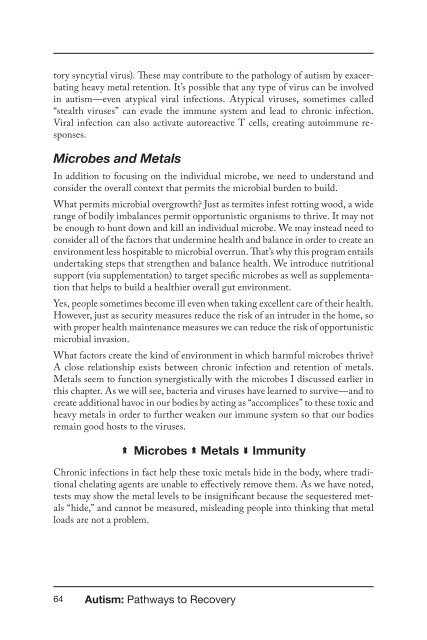3dT4E4Rnm
3dT4E4Rnm
3dT4E4Rnm
Create successful ePaper yourself
Turn your PDF publications into a flip-book with our unique Google optimized e-Paper software.
tory syncytial virus). These may contribute to the pathology of autism by exacerbating<br />
heavy metal retention. It’s possible that any type of virus can be involved<br />
in autism—even atypical viral infections. Atypical viruses, sometimes called<br />
“stealth viruses” can evade the immune system and lead to chronic infection.<br />
Viral infection can also activate autoreactive T cells, creating autoimmune responses.<br />
Microbes and Metals<br />
In addition to focusing on the individual microbe, we need to understand and<br />
consider the overall context that permits the microbial burden to build.<br />
What permits microbial overgrowth Just as termites infest rotting wood, a wide<br />
range of bodily imbalances permit opportunistic organisms to thrive. It may not<br />
be enough to hunt down and kill an individual microbe. We may instead need to<br />
consider all of the factors that undermine health and balance in order to create an<br />
environment less hospitable to microbial overrun. That’s why this program entails<br />
undertaking steps that strengthen and balance health. We introduce nutritional<br />
support (via supplementation) to target specific microbes as well as supplementation<br />
that helps to build a healthier overall gut environment.<br />
Yes, people sometimes become ill even when taking excellent care of their health.<br />
However, just as security measures reduce the risk of an intruder in the home, so<br />
with proper health maintenance measures we can reduce the risk of opportunistic<br />
microbial invasion.<br />
What factors create the kind of environment in which harmful microbes thrive<br />
A close relationship exists between chronic infection and retention of metals.<br />
Metals seem to function synergistically with the microbes I discussed earlier in<br />
this chapter. As we will see, bacteria and viruses have learned to survive—and to<br />
create additional havoc in our bodies by acting as “accomplices” to these toxic and<br />
heavy metals in order to further weaken our immune system so that our bodies<br />
remain good hosts to the viruses.<br />
Microbes Metals Immunity<br />
Chronic infections in fact help these toxic metals hide in the body, where traditional<br />
chelating agents are unable to effectively remove them. As we have noted,<br />
tests may show the metal levels to be insignificant because the sequestered metals<br />
“hide,” and cannot be measured, misleading people into thinking that metal<br />
loads are not a problem.<br />
64 Autism: Pathways to Recovery


